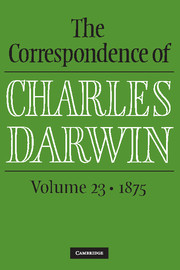Book contents
- Frontmatter
- Frontispiece
- Dedication
- Contents
- List of illustrations
- List of letters
- Introduction
- Acknowledgments
- List of provenances
- Note on editorial policy
- Darwin/Wedgwood genealogy
- Abbreviations and symbols
- The Correspondence
- Appendixes
- Appendix I Translations
- Appendix II Chronology
- Appendix III Diplomas
- Appendix IV Presentation lists for Insectivorous plants and Climbing plants 2d ed.
- Appendix V Reviews of Insectivorous plants
- Appendix VI Darwin and vivisection
- Manuscript alterations and comments
- Biographical register and index to correspondents
- Bibliography
- Notes on manuscript sources
- Index
- Table of Relationship
Appendix IV - Presentation lists for Insectivorous plants and Climbing plants 2d ed.
from Appendixes
Published online by Cambridge University Press: 05 July 2018
- Frontmatter
- Frontispiece
- Dedication
- Contents
- List of illustrations
- List of letters
- Introduction
- Acknowledgments
- List of provenances
- Note on editorial policy
- Darwin/Wedgwood genealogy
- Abbreviations and symbols
- The Correspondence
- Appendixes
- Appendix I Translations
- Appendix II Chronology
- Appendix III Diplomas
- Appendix IV Presentation lists for Insectivorous plants and Climbing plants 2d ed.
- Appendix V Reviews of Insectivorous plants
- Appendix VI Darwin and vivisection
- Manuscript alterations and comments
- Biographical register and index to correspondents
- Bibliography
- Notes on manuscript sources
- Index
- Table of Relationship
Summary
Darwin began writing Insectivorous plants in April 1874 (CD's ‘Journal’ (Appendix II)); it was a subject that he had worked on, on and off, since 1859. He sent the manuscript to John Murray, together with the corrections to Climbing plants, which was originally planned to be included in Insectivorous plants, at the end of March or beginning of April 1875. Climbing plants was then detached from the planned book and sent back to Darwin. Darwin spent the second half of April and most of May working on the proof-sheets of Insectivorous plants, with the help of his son Francis (letter to J. V. Carus, 19 April [1875]; letter to Francis Darwin, 30 April [1875]; CD's ‘Journal’ (Appendix II)). Insectivorous plants was published on 2 July. The first print run was of 1250 copies, but 1700 were sold, so a second printing of 1000 copies was prepared (letter from R. F. Cooke, 3 July 1875). By the time the second printing was ready, all copies were already sold, and another 750 copies were printed (letter from R. F. Cooke, 16 July 1875).
The first edition of Climbing plants was published in 1865 (see Correspondence vol. 13). Darwin sent the paper to the Linnean Society in January 1865 (ibid., letter to J. D. Hooker, 7 January [1865]). An abstract was read before the society on 2 February. The full paper was published as a double issue of the Journal of the Linnean Society in June, and a commercial offprint was made by Longmans and Williams & Norgate, as well as a separate set of author's offprints. No presentation list has been found for the first edition. The second edition was the first to appear in hard covers (Freeman 1977).
Darwin had originally planned to publish the second edition of Climbing plants as part of Insectivorous plants (letter to J. V. Carus, 7 February 1875). His ‘Journal’ (Appendix II) indicates that he worked on corrections to Climbing plants from January to March 1875. In April, however, Murray decided that the two books together were too big, and undertook to publish them as a separate volumes (letter from John Murray, 9 April [1875]; letter to J. V. Carus, 19 April [1875]).
- Type
- Chapter
- Information
- The Correspondence of Charles Darwin , pp. 572 - 575Publisher: Cambridge University PressPrint publication year: 2015
- 1
- Cited by

